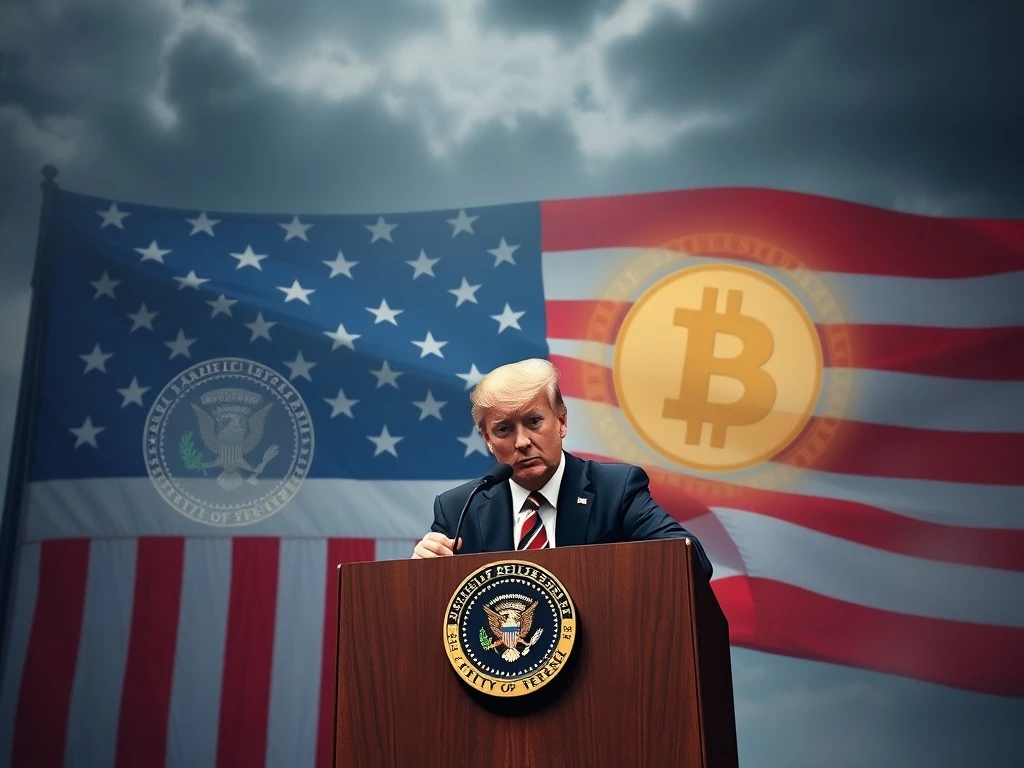Trump Stablecoin Breakthrough: GENIUS Act Propels US Towards Digital Finance Leadership

Are you ready for a seismic shift in the world of digital assets? The cryptocurrency landscape is constantly evolving, but few events carry the weight of a presidential decree. On July 18, 2025, President Donald J. Trump signed the Guiding and Establishing National Innovation for U.S. Stablecoins Act (GENIUS Act) into law, marking a monumental moment for the future of Trump stablecoin policy and the broader crypto market. This bipartisan legislation isn’t just another bill; it’s a strategic move designed to cement the United States’ position as the undeniable leader in digital finance.
Understanding the Transformative Power of the GENIUS Act
The GENIUS Act, officially known as the Guiding and Establishing National Innovation for U.S. Stablecoins Act, is a landmark piece of legislation. Its primary objective is to create a robust and clear regulatory framework for stablecoin issuance within the United States. Before this act, the regulatory environment for stablecoins was often described as a ‘Wild West’ — fragmented, uncertain, and varying across states. The GENIUS Act aims to bring order and credibility to this burgeoning sector by:
-
Mandating Asset-Backed Collateral: A core tenet of the act is the requirement for stablecoins to be fully backed by U.S. dollar reserves on a one-for-one basis. This means for every digital dollar issued, there must be a physical dollar (or equivalent, highly liquid asset) held in reserve. This provision is crucial for building trust and ensuring the stability that stablecoins promise.
-
Enabling Traditional Financial Institutions: The act explicitly allows regulated banks and financial institutions to issue these ‘one-for-one’ asset-backed crypto assets. This is a significant shift, inviting established players into the digital asset space and potentially bridging the gap between traditional finance and decentralized technologies.
-
Fostering Compliance and Growth: By streamlining compliance requirements, the GENIUS Act seeks to reduce regulatory hurdles for legitimate stablecoin issuers. This is expected to foster economic growth, encourage technological advancement, and attract more investment into the U.S. digital asset ecosystem.
Industry experts have been quick to laud the law, with many calling it a ‘seal of approval’ for the crypto sector. This signifies a broader governmental acceptance of digital finance, moving beyond cautious skepticism to proactive regulation. This isn’t just about controlling risk; it’s about channeling innovation responsibly to benefit the U.S. economy.
Why is Stablecoin Regulation So Critical for US Digital Finance?
The need for comprehensive stablecoin regulation has become increasingly apparent as digital assets gain mainstream traction. Stablecoins, by their very nature, aim to provide price stability, typically by pegging their value to a fiat currency like the U.S. dollar. However, without proper oversight, they can pose significant risks:
Benefits of Robust Stablecoin Regulation:
| Benefit | Description |
|---|---|
| Enhanced Trust & Stability | Mandatory asset-backing and transparency requirements build consumer and institutional confidence, reducing the risk of ‘bank runs’ on stablecoin issuers. |
| Reduced Systemic Risk | By integrating stablecoins into the existing financial regulatory framework, the act minimizes potential threats to the broader financial system that could arise from unregulated digital assets. |
| Consumer Protection | Clear rules protect users from fraudulent schemes and ensure that their digital assets are genuinely backed by reserves. |
| Attracting Institutional Investment | Regulatory clarity is a major draw for large financial institutions and traditional investors who require legal certainty before entering new markets. |
Analysts note that the act’s focus on institutional accountability and real-asset backing could attract significant new investment. This move signals a maturing crypto market in the U.S., where regulatory certainty can unlock vast pools of capital previously hesitant to engage with digital assets. It positions the US digital finance landscape for unprecedented growth.
How Does the GENIUS Act Position the U.S. as the Crypto Capital?
President Trump himself emphasized the legislation’s role in making the U.S. the ‘crypto capital of the planet.’ This bold statement reflects the strategic ambition behind the GENIUS Act. By establishing a clear, federal framework, the U.S. aims to:
-
Attract Innovation and Talent: A well-defined regulatory environment encourages blockchain developers, fintech companies, and entrepreneurs to build and innovate within the U.S., rather than seeking friendlier jurisdictions abroad.
-
Global Standard Setting: The U.S. has a history of setting global financial standards. By being among the first major economies to implement comprehensive stablecoin regulation, the GENIUS Act could serve as a blueprint for other nations, solidifying the U.S.’s leadership in the emerging digital economy.
-
Enhance Economic Competitiveness: A thriving digital finance sector contributes to economic growth, job creation, and technological advancement, keeping the U.S. at the forefront of global innovation.
Market observers anticipate significant shifts in investor sentiment and liquidity dynamics as a direct result of this act. While the act primarily focuses on stablecoins, the broader implication is a governmental endorsement of digital assets, which could indirectly boost demand for non-stablecoin cryptocurrencies like Bitcoin.
What Are the Potential Market Impacts and Unaddressed Challenges?
The immediate impact of the GENIUS Act on market dynamics is a subject of intense speculation. While current on-chain data shows minimal weekend volatility, the act’s implementation is expected to amplify demand for digital assets over time. Historical trends suggest that institutional and government investments often boost market activity, potentially leading to increased price adjustments and liquidity fluctuations across the board. The prospect of the U.S. government potentially accumulating Bitcoin reserves, as hinted by some analysts, further adds to this anticipation.
However, no major legislative act comes without its challenges and unaddressed gaps. While the GENIUS Act is a monumental step for stablecoins, it does not address broader crypto regulations for non-stablecoin assets or decentralized finance (DeFi) platforms. This leaves significant gaps in the sector’s governance, raising questions such as:
-
Regulation of Non-Stablecoin Cryptocurrencies: How will assets like Bitcoin, Ethereum, and other altcoins be classified and regulated in the future? Will there be a separate framework, or will existing securities laws be adapted?
-
Decentralized Finance (DeFi) Oversight: DeFi protocols operate without central intermediaries. How will regulators balance the need for consumer protection and anti-money laundering measures with the decentralized nature of these platforms?
-
Balancing Innovation with Oversight: The pace of technological advancement in crypto often outstrips regulatory frameworks. How will federal agencies adapt to rapidly evolving market conditions without stifling innovation?
Implementation will require ongoing collaboration between federal agencies, including the Treasury Department, the Federal Reserve, and industry stakeholders. This collaborative approach will be vital to adapt to evolving market conditions and ensure the regulations remain relevant and effective.
How Does U.S. Stablecoin Regulation Compare Globally?
The legislation’s timing aligns with global efforts by nations and blocs like the European Union to strengthen crypto frameworks. For instance, the EU’s Markets in Crypto-Assets (MiCA) regulation, which is phasing in, provides a comprehensive framework for various crypto assets, including stablecoins. However, the Trump stablecoin initiative gives the U.S. a clearer and potentially more direct regulatory model specifically for stablecoins, focusing on their integration with the traditional financial system through banks.
While MiCA covers a broader range of crypto assets, the GENIUS Act’s focused approach on dollar-backed stablecoins might offer a competitive advantage by attracting stablecoin issuers who prioritize clarity and direct integration with the world’s reserve currency. This could accelerate the U.S.’s path to becoming the undisputed crypto capital, drawing in companies and talent that seek a stable and predictable regulatory environment for their stablecoin operations.
The Road Ahead: What’s Next for US Digital Finance?
The signing of the GENIUS Act is not the end of the journey but rather a significant milestone. It signals a clear commitment from the U.S. government to embrace digital assets, particularly stablecoins, as a legitimate and integral part of its financial infrastructure. This strategic move is expected to have far-reaching implications, from increasing institutional adoption of digital assets to potentially altering global financial power dynamics.
As the U.S. solidifies its position in US digital finance, the world will be watching closely. The success of the GENIUS Act will depend on its effective implementation, the willingness of traditional financial institutions to adapt, and the ongoing dialogue between regulators and innovators. The era of stablecoins is truly upon us, and with this act, the U.S. is firmly steering the ship.
Conclusion: A New Dawn for Stablecoins
The signing of the GENIUS Act by President Trump represents a pivotal moment for the cryptocurrency industry and the broader global financial landscape. By establishing a clear, comprehensive stablecoin regulation framework, the U.S. has taken a definitive step towards securing its role as the global crypto capital. This legislation promises enhanced stability, greater consumer protection, and a significant boost to innovation within the US digital finance sector. While challenges remain, particularly concerning non-stablecoin assets and DeFi, the GENIUS Act lays a strong foundation for a more integrated and regulated digital economy. The future of finance is digital, and with this landmark act, the United States is firmly steering the ship.
Frequently Asked Questions (FAQs)
Q1: What is the primary purpose of the GENIUS Act?
A1: The primary purpose of the Guiding and Establishing National Innovation for U.S. Stablecoins Act (GENIUS Act) is to establish a comprehensive regulatory framework for stablecoin issuance in the United States. It aims to mandate asset-backed collateral for stablecoins, allow traditional financial institutions to issue them, and position the U.S. as a leader in digital finance.
Q2: How does the GENIUS Act define stablecoins?
A2: The GENIUS Act defines stablecoins as digital assets that are designed to maintain a stable value relative to a specific fiat currency, primarily the U.S. dollar. It mandates that these stablecoins must be fully backed by U.S. dollar reserves on a one-for-one basis, ensuring their stability and reliability.
Q3: What are the key benefits of this new stablecoin regulation for investors and consumers?
A3: For investors and consumers, the GENIUS Act brings enhanced trust and stability through mandatory asset-backing and transparency. It offers greater consumer protection by reducing risks associated with unregulated digital assets and aims to attract more institutional investment, potentially leading to a more robust and secure digital asset market.
Q4: Does the GENIUS Act regulate all cryptocurrencies, or just stablecoins?
A4: The GENIUS Act specifically focuses on regulating stablecoins. It does not directly address broader regulations for non-stablecoin cryptocurrencies like Bitcoin or Ethereum, nor does it cover decentralized finance (DeFi) platforms. These areas remain potential gaps in the U.S. crypto regulatory landscape that may be addressed in future legislation.
Q5: How does the GENIUS Act impact the U.S.’s position in the global digital finance landscape?
A5: By creating a clear and robust regulatory framework for stablecoins, the GENIUS Act aims to solidify the U.S.’s position as the global ‘crypto capital.’ It seeks to attract innovation, talent, and investment, potentially setting a global standard for stablecoin regulation and enhancing the U.S.’s economic competitiveness in the evolving digital economy.
Q6: When did the GENIUS Act become law?
A6: President Donald J. Trump signed the Guiding and Establishing National Innovation for U.S. Stablecoins Act (GENIUS Act) into law on July 18, 2025.









